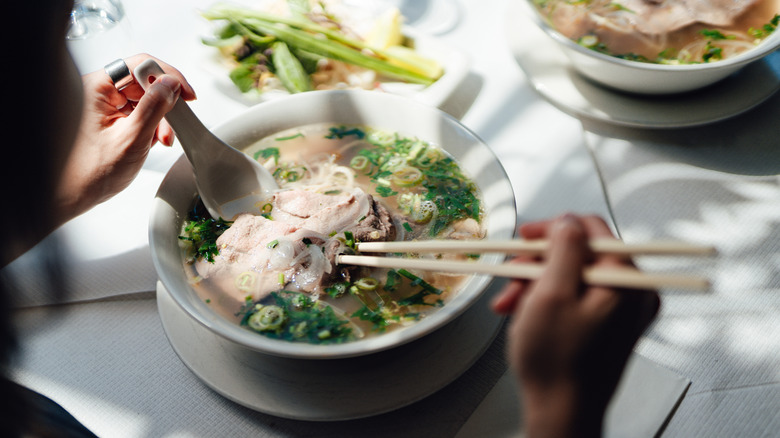Pho Hasn't Been In The US As Long As You Might Have Expected
The cultural mark that phở has made feels timeless. It occupies a culinary space seemingly carved over the course of generations, even outside its birthplace in Vietnam. Phở (pronounced "fuh") is a soup typically composed of rice noodles and meat in a seasoned broth, and it holds a central place in Vietnamese culture as its unofficial national dish. Although phở has solidified its popularity and become nearly synonymous with Vietnamese cuisine all over the world, the dish is relatively new to the U.S.
The year was 1975. North Vietnamese forces captured Saigon, the capital city of South Vietnam, prompting the South Vietnamese government to surrender and effectively end a 30-year conflict. On the heels of this struggle's conclusion, more than 2.5 million refugees fled to other countries, and around 140,000 of that number evacuated to the U.S. As they resettled in new places, they brought with them their culinary traditions, offering a taste of home to their families and new Vietnamese communities and eventually opening restaurants and shops dedicated to phở. Because of initial difficulty accessing certain ingredients, as well as adjustments for American tastes, stateside phở evolved from its original form to include more meat and seasonings. By the early 2000s, phở was widespread in the U.S. That said, you may still struggle with how to eat a bowl of phở like you know what you're doing.
Pho is a semi-modern phenomenon with a meteoric rise
Phở's late arrival in the U.S. makes sense when you consider its history, but truthfully, the dish isn't all that much older in Vietnam. It's a North Vietnamese dish developed in Nam Dinh province and popularized in Hanoi, the capital city of the area once called Indochina. Although phở's genesis is somewhat obscure, many experts agree that it came to be around the late 19th or early 20th century during the height of French colonization. Before the French occupied the country, the meat of choice was typically buffalo, but French colonists preferred beef. However, there were cheap cuts the French usually wouldn't eat, so Vietnamese street vendors would collect the unwanted beef and add it to existing dishes of broth with noodles. Eventually, round rice noodles gave way to flat rice noodles, and flavors were revised. Thus, phở was born.
Some historians connect phở to the French pot-au-feu, which is a beef and vegetable stew whose name sounds similar. Other historians believe it evolved from dishes served by Chinese street vendors, who were making good use of the new beef abundance. Regardless of the exact inception, love of phở spread through the country and withstood the test of time. In 2014, pho was added to the dictionary, and in 2018, Vietnam established the Day of Phở on December 12.
How pho has changed throughout history
Vietnamese refugees resettling in the U.S. prompted a change in phở's flavors, but that was hardly the dish's first evolution. After its creation in the late 1800s and its rise in popularity, different regions of Vietnam developed their versions of the unofficial national dish — like Nam Dinh's garlic and tomato phở and Hanoi's simplistic phở. When a 1939 law prohibited selling beef on certain days, chicken phở sprung into being as an alternative.
One of the most significant changes in phở composition came about in the 1950s. In 1954, French colonial rule ended, and the country was split into northern and southern sections. Before an election in 1956, the borders were opened, and about 1 million Vietnamese people migrated. Those from North Vietnam brought their phở (called phở bắc) to the south, and the recipes changed — adding more sweetness, more herbs, and additions like soy sauce. The new southern version was called phở nam.
The beloved soup continued its evolution, and the ingredients, flavors, and garnishes for a bowl of phở reflect the communities and cultures in which it found a home. Despite its fairly recent birth and even more recent U.S. establishment, phở isn't going anywhere.



